The ID Card Printer market is witnessing consistent growth, driven by the increasing demand for secure identification systems across corporate, government, healthcare, and educational institutions. Rising emphasis on access control, workforce management, and identity verification is contributing to the widespread adoption of card printing solutions. Technological advancements such as smart card encoding, holographic overlays, and mobile printing compatibility are enhancing security features and operational efficiency.
Furthermore, growing digital transformation initiatives and regulatory compliance requirements for identity authentication are propelling the demand for advanced printing technologies. Organizations are increasingly adopting ID card printers for on-demand issuance of employee badges, student IDs, and membership cards, which support both security and branding objectives.
The market is also benefiting from the expansion of small and medium enterprises, which are integrating ID printing systems to streamline operations and ensure workplace safety As businesses prioritize data protection and identity management, the ID Card Printer market is expected to experience sustained growth, supported by innovation, automation, and improved cost efficiency in printing systems.
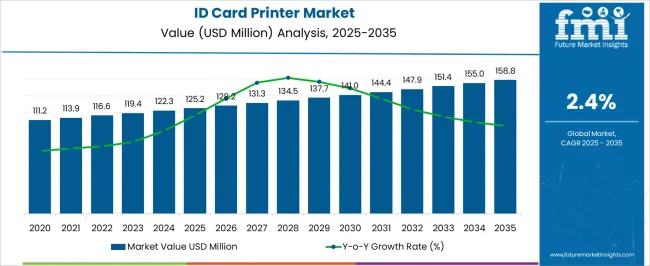
| Metric | Value |
|---|---|
| ID Card Printer Market Estimated Value in (2025 E) | USD 125.2 million |
| ID Card Printer Market Forecast Value in (2035 F) | USD 158.8 million |
| Forecast CAGR (2025 to 2035) | 2.4% |
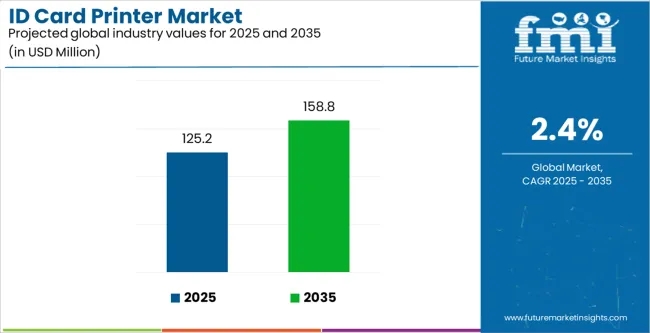
The market is segmented by Product, Technology, Sales Channel, and End User and region. By Product, the market is divided into Double-Sided Card Printers, Single-Sided Card Printers, High-Performance Card Printers, and Standard Card Printers. In terms of Technology, the market is classified into Direct-To-Card/Dye Sublimation, Reverse Transfer, Rewritable, and Encoding. Based on Sales Channel, the market is segmented into Offline and Online. By End User, the market is divided into Government Institutions, Industrial/Manufacturing, Banking, Healthcare, and Educational Institutions. Regionally, the market is classified into North America, Latin America, Western Europe, Eastern Europe, Balkan & Baltic Countries, Russia & Belarus, Central Asia, East Asia, South Asia & Pacific, and the Middle East & Africa.
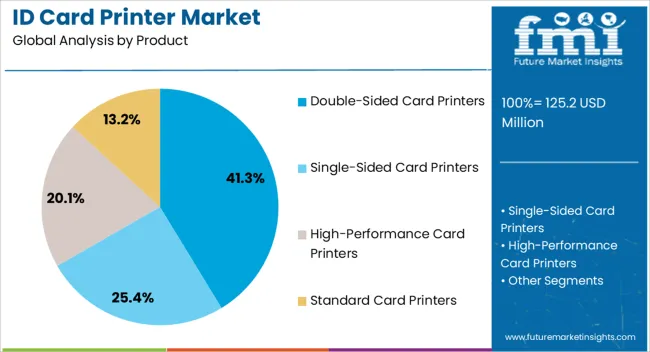
The double-sided card printers segment is projected to account for 41.3% of the ID Card Printer market revenue share in 2025, making it the leading product type. Growth in this segment is being driven by the ability to print detailed information on both sides of the card, optimizing space for personalization, security features, and branding elements. Double-sided printers enhance efficiency by reducing the time required for manual card flipping, which improves productivity in high-volume printing environments such as corporate offices, government agencies, and universities.
These systems also support advanced encoding for magnetic stripes and RFID chips, ensuring compatibility with access control systems. Their flexibility in handling various card materials and integration with software-based design tools adds to their appeal.
Additionally, advancements in printing speed and resolution are improving overall output quality The demand for multi-functional, space-efficient, and secure identification systems continues to support the strong adoption of double-sided printers globally, positioning the segment as a key revenue driver in the market.
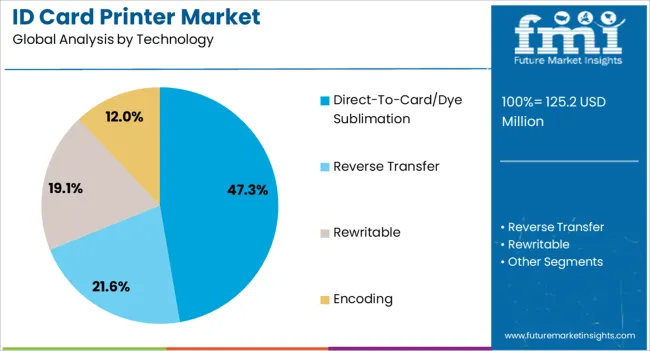
The direct-to-card or dye sublimation technology segment is expected to hold 47.3% of the market share in 2025, emerging as the dominant printing technology. This segment’s growth is attributed to its ability to produce high-resolution, durable, and visually appealing ID cards at a competitive cost. The dye sublimation process ensures smooth color gradients and edge-to-edge printing, making it suitable for applications requiring professional-grade card aesthetics.
Its simplicity, compact design, and ease of maintenance have made it the preferred choice among small and medium-sized businesses as well as large enterprises. Furthermore, continuous improvements in printhead technology and ribbon efficiency are enhancing cost-effectiveness and performance.
The ability to integrate with security software for data encryption and image authentication also adds value to this segment As organizations increasingly seek reliable, fast, and secure ID card printing solutions, the direct-to-card or dye sublimation technology segment is expected to maintain its leading position in the market over the forecast period.
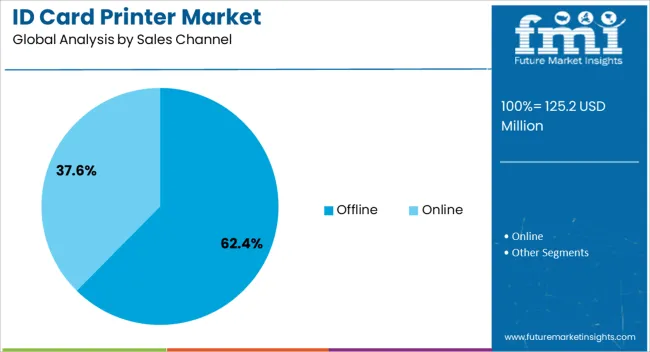
The offline sales channel segment is projected to capture 62.4% of the ID Card Printer market revenue share in 2025, positioning it as the dominant distribution channel. This leadership is primarily driven by the preference for hands-on product demonstrations, after-sales service support, and customized installation solutions provided by offline distributors and retailers. Businesses often rely on in-person consultations to assess printer compatibility, security features, and performance capabilities before purchase, especially for bulk or specialized orders.
The offline channel also enables immediate access to accessories, consumables, and maintenance services, ensuring uninterrupted operations. Additionally, partnerships between manufacturers and authorized resellers are strengthening the supply network and improving customer experience.
In developing economies, offline channels remain essential due to limited e-commerce penetration and the need for direct engagement with end-users As enterprises continue to invest in secure printing infrastructure, offline distribution will retain its significance, supported by personalized service delivery, reliability, and stronger customer relationships driving sustained market dominance.
Businesses can Leverage the Digital Empowerment in the Education Sector
With applications like access control, payment systems, and secure authentication, smart cards are being increasingly adopted. The development of smart card technology raises the demand for ID card printers that can encode and print these sophisticated cards.
Several businesses are ushering in a new era of digital solutions for various demographics. As such, in February 2025, LEO1, a prominent Edu-fintech business, launched India's first limitless prepaid student ID card in collaboration with NSDL Payments Bank and Mastercard as part of its Financial SAAS for Educational Institutions.
This unique card acts as a secure prepaid card and a student ID card, representing a significant breakthrough in digitizing financial transactions in educational institutions. Considering this development, businesses manufacturing ID card printers and edu-fintech firms can explore partnership opportunities.
Hybrid ID Card Printer Sales and Innovations Continue to Increase
Staying competitive in today's ever-changing corporate environment requires flexibility and adaptation. Organizations are coping with a wide range of printing demands with unprecedented flexibility using hybrid ID card printers that enable direct-to-card and retransfer printing processes. With the help of these printers, customers can select the best printing option depending on the card's security features, print quality, and durability.
Businesses can succeed in operations and sustainable development by using hybrid ID card printers to improve printing processes, optimize workflow efficiency, and adapt smoothly to changing business demands. Thus, demand for hybrid ID card printers is rising through both the customer-centric and commercial-centric avenues.
Rise of Unmanned Card Printing Kiosks Boosts Growth in the Market
In busy places like airports, colleges, and business campuses, unmanned card printing kiosks are becoming a popular self-service option for quick ID card issuance. These ID card design and printing kiosks eliminate the need for central printing facilities and shorten turnaround times by enabling customers to create and print ID cards immediately.
Organizations can boost accessibility, improve customer service, expedite the card issue process, and improve overall operational efficiency by using on-demand printing kiosks. Leveraging this potential, in April 2025, Nidec Instruments Corporation launched a new card-printing-issuing machine for unmanned kiosk terminals.
| Segment | Double-sided Card Printers (Product Type) |
|---|---|
| Value Share (2025) | 41.30% |
Based on product type, the double-sided card printers are set to occupy 41.30% of the product type segment in 2025. Multi-functional cards with extra features and capabilities are becoming popular as applications for ID cards evolve beyond basic identification. Organizations use double-sided card printers to embed magnetic stripes, smart card chips, or RFID technology on cards.
This makes them useful for a variety of purposes, including time monitoring, cashless payments, access control, and more. Double-sided ID card printers are thus becoming essential for businesses.
| Segment | Direct-to-Direct Card Printer (Technology) |
|---|---|
| Value Share (2025) | 47.30% |
Direct-to-direct card printers under the technology segment are set to account for 47.30% of the ID card printer market share in 2025. Organizations are enamored of direct-to-card printers' ability to generate high-quality ID cards with speed and reliability. Direct-to-card printers are proving to be an excellent investment for companies and organizations that need to print large volumes of documents quickly and efficiently.
| Countries | Value CAGR (2025 to 2035) |
|---|---|
| United States | 0.7% |
| Germany | 0.5% |
| Japan | 1.9% |
| China | 4.9% |
| India | 5.4% |
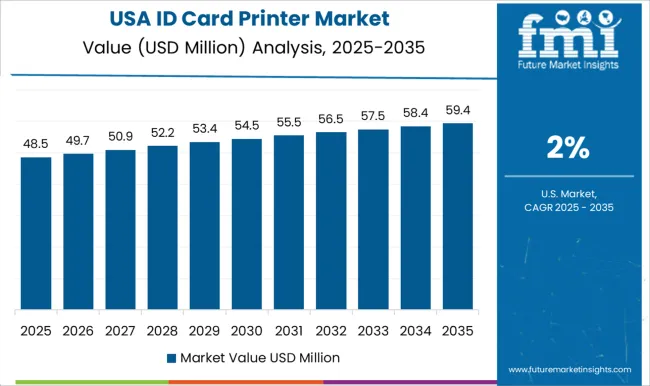
The demand for ID card printers in the United States will surge at 0.7% CAGR through 2035. This growth is attributed to the surge in demand for ID card printers in banks and educational institutions, the dominance of top ID card printer manufacturers, and ongoing technological developments in card printer technology.
Since ID cards are required for several operations, including opening bank accounts, high-performance ID card printers with accessories are becoming more essential. In the United States, over 65% of individuals now own credit cards as a result of their greater disposable income. The banking sector's growing dependence on cashless transactions, such as credit and debit card usage, also sees demand rise.
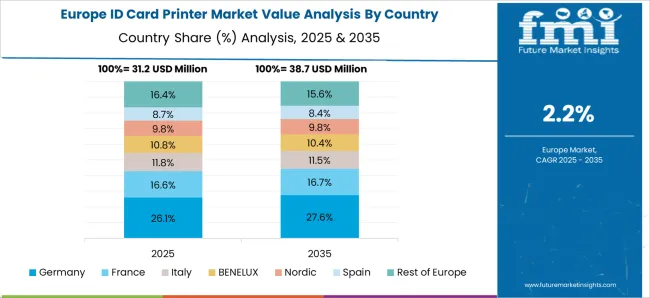
The sales of ID card printers in Germany are set to increase at 0.5% CAGR through 2035. The German government has provided 820 million euros in financing for model projects that are going to examine Smart City concepts and implementation procedures in German towns and cities.
ID card printers play a critical part in these projects by facilitating the issuing of smart cards for citizens, residents, and visitors. Smart cards have several applications, such as digital services, access control, and public transit, which help create smart cities. Incorporating ID card printers into smart city efforts allows manufacturers to offer customized solutions that cater to the changing requirements of metropolitan settings.
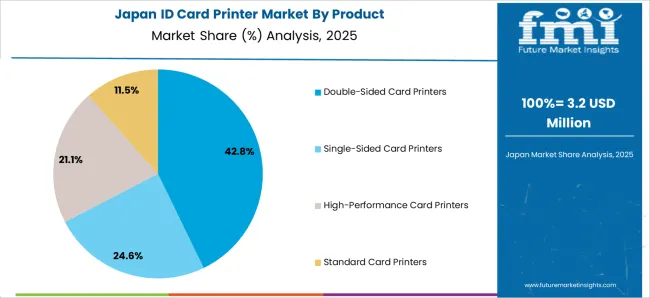
The ID card printer market growth in Japan is estimated at 1.9% CAGR through 2035. ID card printers with advanced safety features and identification capabilities are in high demand in Japan due to the country's strong cultural focus on security, trust, and dependability.
To protect confidential data and stop illegal access, Japanese organizations prioritize security methods, including encryption, biometric authentication, and tamper-evident printing. Organizations looking to maintain integrity, trust, and compliance with laws like the Act on the Protection of Personal Information are particularly interested in ID card printers that can fulfill these strict security criteria.
Japan is set to gain biometric access and payment cards due to a partnership between IDEX Biometrics and KONA I. KONA I anticipates that in the second part of 2025, banks will start providing customers with new biometric ID cards.
ID card printer sales in China will amplify at 4.9% CAGR through 2035. Due to China's quest for economic integration and digital payments, ID card printers are experiencing more demand in the banking, fintech, and payments industries. To support digital transactions, account opening, and client verification, the country is moving toward a cashless society.
To achieve this, safe and trustworthy identity solutions are required. Financial institutions are looking to improve security, stop fraud, and offer seamless client experiences. As a result, they are demanding ID cards with biometric authentication, magnetic stripe encoding, and embedded EMV chips, necessitating the use of ID card printers.
The demand for ID card printers in India will surge at 5.9% CAGR through 2035. The Indian government has started various projects to improve access to public services and encourage digital identification. There is a high demand for ID card printers due to initiatives like Aadhaar and Digital India, which attempt to make India a digitally enabled nation. These printers are necessary to print voter ID cards, Aadhaar cards, and other government-issued documents and thus their demand in India is being fueled.
The ID card printer market is extremely competitive, with significant competitors such as HID Global, Zebra Technologies Corporation, and Datacard Group at the forefront. These firms invest in R&D to develop innovative technologies such as biometric authentication and cloud-based printing.
Niche firms such as Evolis and Magicard Ltd. concentrate on specialized applications, but local players and new entrants add variation. Pricing tactics, distribution networks, and after-sales assistance impact competitive dynamics and are essential for market penetration and customer satisfaction.
Recent Developments
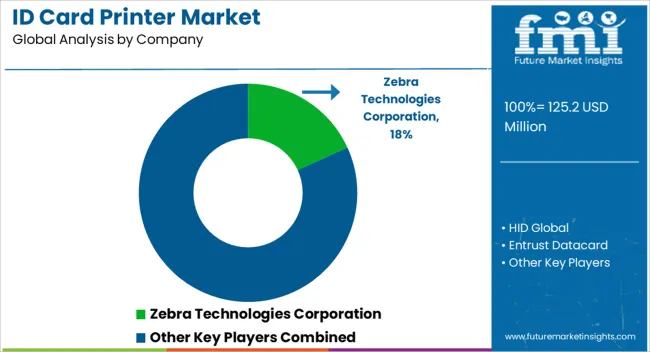
The global ID card printer market is estimated to be valued at USD 125.2 million in 2025.
The market size for the ID card printer market is projected to reach USD 158.8 million by 2035.
The ID card printer market is expected to grow at a 2.4% CAGR between 2025 and 2035.
The key product types in ID card printer market are double-sided card printers, single-sided card printers, high-performance card printers and standard card printers.
In terms of technology, direct-to-card/dye sublimation segment to command 47.3% share in the ID card printer market in 2025.






Full Research Suite comprises of:
Market outlook & trends analysis
Interviews & case studies
Strategic recommendations
Vendor profiles & capabilities analysis
5-year forecasts
8 regions and 60+ country-level data splits
Market segment data splits
12 months of continuous data updates
DELIVERED AS:
PDF EXCEL ONLINE
Identity And Access Management As A Service (IAMaaS) Market Size and Share Forecast Outlook 2025 to 2035
Identity Governance and Administration Market Size and Share Forecast Outlook 2025 to 2035
Identity Verification Market Analysis - Size, Share, and Forecast 2025 to 2035
Identity Analytics Market Size and Share Forecast Outlook 2025 to 2035
Idiopathic Pulmonary Fibrosis Management Market - Growth & Drug Advances 2025 to 2035
Idiopathic Thrombocytopenic Purpura Therapeutics Market Growth - Trends & Forecast 2025 to 2035
Identity & Access Management Market Growth – Demand, Trends & Forecast 2025-2035
Identity-as-a-Service (IDaaS) Market Outlook 2025 to 2035 by Access Type, Enterprise Size, Service Type, Application, Industry, and Region
ID Verification Market
Mid Wave Mid-IR Supercontinuum Laser Market Forecast and Outlook 2025 to 2035
Rider Pallet Truck Market Forecast and Outlook 2025 to 2035
Video Processing Platform Market Size and Share Forecast Outlook 2025 to 2035
Ride-On Mower Market Size and Share Forecast Outlook 2025 to 2035
Video Test Equipment Market Size and Share Forecast Outlook 2025 to 2035
Sidewinder Machine Market Size and Share Forecast Outlook 2025 to 2035
Riding Multi-Purpose Lawn Mower Market Size and Share Forecast Outlook 2025 to 2035
Side Load Case Packing Machines Market Size and Share Forecast Outlook 2025 to 2035
Bidirectional Charging Units Market Size and Share Forecast Outlook 2025 to 2035
Middle East & Africa Sachet Packaging Machines Market Size and Share Forecast Outlook 2025 to 2035
Mid-Lift Axle Market Size and Share Forecast Outlook 2025 to 2035

Thank you!
You will receive an email from our Business Development Manager. Please be sure to check your SPAM/JUNK folder too.
Chat With
MaRIA